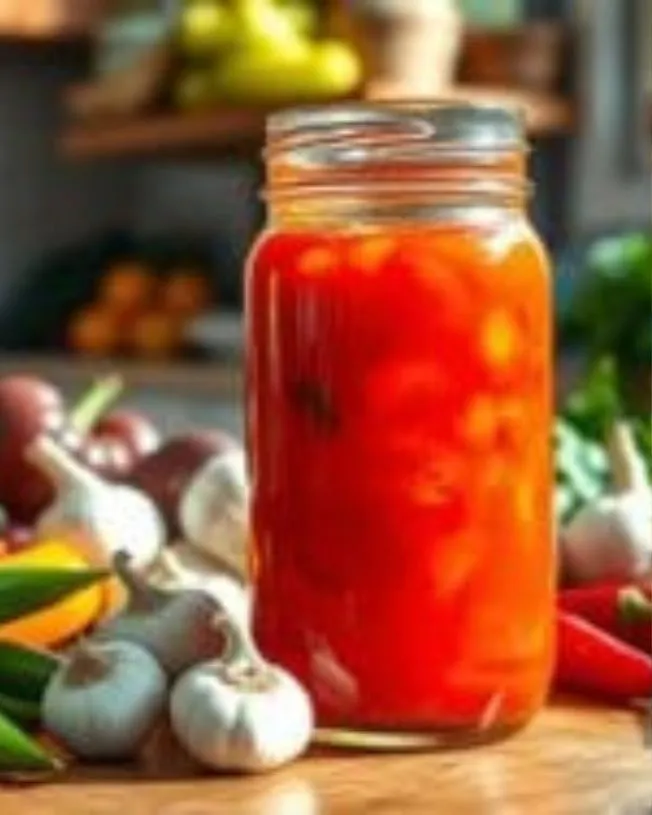
Fermented Hot Sauce
This homemade fermented hot sauce is easy to make, customizable to your taste, and adds a zesty, spicy kick to any dish. Perfect for heat lovers, it’s packed with flavor and a fun kitchen project that results in a tangy, bold sauce!
Ingredients
- Hot Peppers 500g / about 1 lb
- Use any variety you love: jalapeños habaneros, or cayenne. A mix adds complexity!
- Garlic 4-6 cloves
- Adds depth and a savory kick.
- Salt 2 tablespoons, preferably sea salt
- Essential for fermentation. Establishes an ideal environment for the growth of beneficial microbes.
- Water 2 cups filtered or non-chlorinated water
- Prevents interference with fermentation microbes.
- Optional Additions:
- Onion ½ small onion, diced for sweetness.
- Carrots 1-2 small, chopped to mellow out heat.
- Fruit mango or pineapple for a tropical twist.
- Spices 1 tsp of cumin or smoked paprika to enhance flavor.
Instructions
Prepare the Ingredients
- Wash the hot peppers thoroughly. Remove the stems and chop them into small pieces (you can keep the seeds for extra heat).
- Peel the garlic and roughly chop any additional vegetables like onions or carrots.
Create the Brine
- In a clean jar, dissolve 2 tablespoons of salt in 2 cups of filtered water.
Pack the Jar
- Layer the peppers, garlic, and optional ingredients (e.g., onion or fruit) into the jar. Pack them tightly but leave about 1 inch of space at the top.
Add the Brine
- Pour the salted water into the jar until the ingredients are fully submerged. Use a fermentation weight or small plate to keep them below the liquid level.
Cover and Ferment
- Cover the jar with a clean cloth or fermentation lid to allow air circulation while preventing contaminants.
- Store in a cool, dark place for 5-7 days (or up to 2 weeks for a more complex flavor). Check daily to ensure everything stays submerged.
Check Fermentation Progress
- After 5 days, taste the brine. It should have a tangy, slightly sour flavor. Continue fermenting if desired.
- Blend the Sauce
- Once fermentation is complete, transfer the mixture (peppers and brine) to a blender. Blend until smooth. Adjust the texture by incorporating extra brine or water to achieve your desired consistency.
Season and Strain
- Taste the sauce and adjust with salt or spices like smoked paprika.
- For a smoother texture, strain the sauce through a fine mesh sieve.
Bottle and Store
- Pour the sauce into sterilized bottles or jars. Keep it stored in the refrigerator, where it can last for several months while maintaining its flavor.
- Use your fermented hot sauce to spice up tacos, eggs, or grilled dishes!
Video
Notes
- Adjust the Heat: If you’re not into super spicy sauces, swap out some of the hot peppers for milder ones like bell peppers or add a touch of sweetness with fruits like pineapple or mango.
- Safety First: Handling hot peppers can irritate your skin and eyes. Trust me, gloves are your best friend here—I learned that the hard way!
- Fermentation Tips: If you see bubbles or a slightly tangy aroma, that’s a good sign your fermentation is on track. Ensure that all ingredients remain fully submerged in the brine during fermentation for optimal results.
- For a smoother sauce, pass the blended mixture through a fine-mesh strainer to remove any solids.
- Custom Consistency: For a thicker sauce, reduce the amount of brine when blending. Would you prefer a smoother finish?
- Flavor Experimentation: This recipe is a great base for experimentation. To tweak the flavor profile, try adding smoked paprika, cumin, or even a splash of vinegar post-fermentation.
- Storage Note: While it’s tempting to use the sauce immediately, letting it sit in the fridge for a few days after bottling enhances the flavors beautifully.
- Pairing Suggestions: This sauce is fantastic on tacos, eggs, roasted veggies, or even as a marinade for chicken. Share how you use it in the comments—I’d love to hear your ideas!